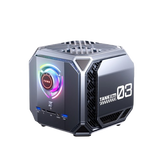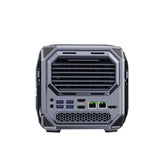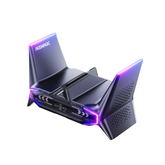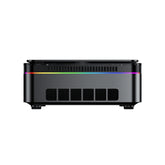Below FAQ are some common concerns of our clients before purchasing the theme.
If you have other questions, please just send it to service@acemagic.com.
- All
- FAQ(MiniPC Universal)
Need Help?
If you have an issue or question that requires immediate assistance, you can drop us an email and we will get back to you within 20-36 hours!
FAQ(MiniPC Universal)
- Step 1: Open the "Device Manager" on your computer.
- Step 2: Find the wireless network card device that needs to be connected to WIFI under "Network Card Adapter" in the device manager interface.
- Step 3: The property setting interface of the wireless network card appears. In order to avoid the frequency of disconnection, especially when the computer is idle. We can uncheck the "Allow the computer to turn off this device to save power" under the "Power Management" tab.
- Step 4: Switch to the "Advanced" tab, select Wireless Mode, and select "IEEE 802.11a/n/ac" in the value to connect to the 5G frequency band of WiFi.
Method 1: Change the Mini PC network settings
- Step 1. Enter the wireless settings, and name the 2.4G and 5G wireless network names (SSID) respectively to distinguish them.
- Step 2. Set the encryption method, password and other parameters of 2.4G and 5G respectively, pay attention to keep the parameters consistent, so as to facilitate the automatic switching of the device.
- Step 3: Save the settings, restart the router, and the settings will take effect. It is recommended to consult the wireless router manufacturer for details.
Method 2: Change the wireless router settings[Need to confirm that the wireless router can transmit dual-frequency signals]
- Open [Settings] - [Network and Internet] - [Advanced Network Settings] - [More Network Adapter Options] - find and double-click to open the currently connected WiFi - [Properties] - double-click to open [Internet Protocol Version 4 (TCP/IPv4) 】 -Select [Obtain IP address automatically] + [Obtain DNS server address automatically】 -restart the computer after confirmation
Scenario 1: Change the IP address
- Search [Internet Options] in the taskbar search box - select [Connection] - open [LAN Settings] - uncheck [Use a proxy server for LAN (these settings are not used for dial-up or VPN connections)] - restart the computer after confirming
Solution 2: Uncheck [Proxy Server]
- Open [Device Manager] - find and open [Network Adapter]
- Double-click to open the WiFi module driver (such as Realtek 8821CE Wireless LAN 802.11ac PCI-E NIC) - [Power Management] - uncheck [Allow the computer to turn off this device to solve the power problem] Double-click to open the network card driver (such as Realtek PCIe GBE Family Controller) - Power Management - uncheck [Allow the computer to turn off this device to solve the power problem]
Scenario 3: Change NIC Power Management
- Search [Network Reset] in the taskbar search box - open it and click [Reset Now] After resetting the network (check if there is any abnormality in the WiFi driver), if there is any abnormality, you need to reinstall the driver
Scenario 4: Network Reset
- Restore the router to factory settings, then restart the computer and router
Solution 5: Reset the router
- Make sure that Bluetooth is turned on: First, make sure that the Bluetooth function on your computer is turned on. Bluetooth options can usually be found in the operating system's settings menu.
- Check device visibility: Make sure your Bluetooth device (such as headset, keyboard, mouse, etc.) is set to be discoverable by other devices. Some Bluetooth devices may be hidden by default and need to be manually set to be visible
- Update the Bluetooth driver: Make sure you have installed the latest Bluetooth driver on your computer. (go to the official website or via the forum to download and install the latest driver)
- Restart the Bluetooth adapter: Try to find the Bluetooth adapter in the device manager, disable it for a while and then re-enable it to see if the device can be reconnected.
- Solve interference: Surrounding wireless devices or electronic devices may interfere with the Bluetooth signal. Try moving other wireless devices or sources of interference away and try connecting again.
- Re-pair the device: If you have paired the Bluetooth device before, try unpairing and re-pairing, which may help to solve the connection problem.
- Reinstall the system
- If the above steps are invalid, there may be a hardware failure.
How to solve the problem of turning on bluetooth but no bluetooth devices can be found
- 1. Press RESET with the pin for 5~10 seconds
- 2. Reinstall the memory
- 3. Please use the correct specifications of the original adapter and power cord
- 4. Please confirm whether the adapter connector, power cordend/B socket end/C computer end are loose, or you can try to replace thesocketNote: Different models of computer adapters may have different styles
- 5. Please check whether the adapter wire is damaged, if so, please replace the adapter for testing
- 6. Please remove all external devices, including USB/memory card/network cable/HDMI, etc.
- 7. Before the problem occurs, have you ever expanded the harddiskormemory? If so, please restore to the factory default state first.
- 8. Remove the adapter, then press and hold the power buttonfor 40seconds (press and hold it) to reset the CMOS
- 9. After connecting the adapter, press the power button to confirmwhether it can be turned on normally
1). After pressing the power button, there is no picture on the screenand the power indicator light is off
If the power indicator light is off, it may be that the adapter cannot supplypower orthe main components are abnormal and cannot be turned on.
- 1. Press RESET with the pin for 5~10 seconds
- 2. Reinstall the memory
- 3. Please try to turn on the monitor switch to confirmwhether thereisno picture due to shutdown.
- 4. Please try to re-plug the HDMI cable to confirmwhether thereis nopicture due to poor contact.
- 5. Please try to change the display input method (HDMI/VGA/DP) toconfirm whether there is no picture due to different input methods.
- 6. Please try to connect the computer to other monitors to confirmwhether it can be displayed normally.If you do not have other monitors, or other monitors have no picture, please skip this step.
- 7. Please try to execute Microsoft's shortcut key: Windows logokey+Ctrl + Shift + B to restore display related settings.
- 8. Please remove all external devices, including USB/memory card/network cable/HDMI, etc.
- 9. Before the problem occurs, have you ever expanded the harddiskormemory? If so, please restore to the factory default state first.
- 10. Turn off the computer (press and hold the power button for 15seconds until the power light goes out, perform a forced shutdown) and remove the adapter, then press and hold the power buttonfor 40seconds (hold down) to reset the CMOS.
- 11. After connecting the adapter, press the power button to confirmwhether it can be turned on normally.
2). After pressing the power button, there is no picture on the screen, and the power indicator light is on
If the power indicator light is on, it means that the motherboard is over- powered, but it may not be able to boot due to some devices.
3). After pressing the power-on button, there will be a screenwhenbooting up, but there will be no screen after entering the desktop.
If you can see the welcome icon of Windows when you turn it on, but it will beblack after entering the desktop.It may be caused by the display adapter driver. It is recommended to enter safe mode. enter safe mode ▪ You can refer to How to enter the safe mode when the Windows system cannot be entered.
- Check for external devices or any hardware devices that have been installed/changed Sometimes, external devices connected to the computer can be the reason for automatic shutdown/restart, so try removing them such as external hard drives, printers, memory cards, dongles, etc. After that, restart your computer. If you don't experience problems after restarting your computer, an external device may be the cause of the problem. We recommend that you do not use this device and contact your device manufacturer for support.
- If you are not using any external devices or the problem persists after removing them, verify if you have installed/replaced any hardware devices such as disk drives (HDD or SSD) or memory modules. Compatibility issues may be the cause and exist between the new hardware device and the product/system, so try removing the hardware device.
- If you do not experience this issue after removing the hardware device, we recommend that you do not use the device and contact the device manufacturer for support.
- If the problem persists after the above steps, continue to the next chapter for troubleshooting. Check for recently installed/updated software or applications.
- Some issues may arise after Windows updates or specific applications installed on your computer, including compatibility issues between applications and the system, or core Windows programs may crash. You can view update history to check recently installed updates.
-
1. Type and search [Windows Update Settings] in the Windows search bar and click [Open]
2. Select [Update History]
3. In the update history, it will list the installed feature updates, quality updates, driver updates, etc. on your computer.
- You can confirm the installation date and whether you are experiencing auto-shutdown/restart issues afterwards, then follow the steps below to learn how to uninstall or return to a previous version.
-
Uninstall quality Windows updates
Return to previous driver version
Uninstall specific applications
- If there are compatibility issues between the initially installed application and the Windows system, automatic shutdown/restart issues may occur, so we recommend that you uninstall the application first.
- If the problem persists after uninstalling this application, we recommend that you check the supported operating systems or specifications on the official website of this application or contact the application manufacturer for support.
- If the problem persists after the above steps, continue to the next chapter for troubleshooting.
- Perform a Windows System Restore
- If all troubleshooting steps have been completed but the problem persists, back up your personal data and then perform a system restore to roll your computer back to its original system. Learn more:
- Reference: [How to restore the system and remove personal files, applications and settings] & [How to restore the system and keep personal files]
- Reinstall Windows system
- If all troubleshooting steps have been completed but the problem persists, please back up your personal data and then reinstall your system. Learn more:
- Reference: [How to reinstall the system]
- If your problem is not resolved, please contact us for further information.
1). After pressing the power button, there is no picture on the screenand the power indicator light is off
If the power indicator light is off, it may be that the adapter cannot supplypower orthe main components are abnormal and cannot be turned on.
Remove external devices and update Windows packages and drivers on your computer to the latest versions.
Remove external devices, such as external hard drives, printers, memory cards, including adapter cards in card readers, etc.
Updating software often helps with system stability and optimization, so we recommend that you check and frequently update to the latest version in your PC.
- 1. Right-click the [Start Menu] icon, and then click [Device Manager].
- 2. Check the arrow next to [Display Adapter] (620), then right-click [Intel® UHD Graphics] and select [Properties].
- 3. Select [Driver] and then select [Rollback Driver].
- 4. Select [Why rollback? ] and click [Yes]. The system will begin rolling back to the previously installed driver.
Problems after installing or updating software, including drivers, applications, or Windows updates.
If problems occur after installing or updating the software, try removing or rolling back to a previous version.
How to roll back to a previously installed driver via Device Manager:
Improve Windows performance
See Microsoft recommendations for checking and setting up in Windows to learn more about tips for improving your PC's performance in Windows.
https://support.microsoft.com/en-us/windows/tips-to-improve-pc-performance-in-windows-b3b3ef5b-5953-fb6a-2528-4bbed82fba96
Restore system via system restore point
If the problem started recently, and if you have previously created a system restore point or an automatic restore point created by the system, you can try to restore the system to a point in time before the problem started to solve the problem. Learn more [How to restore your system from an established system restore point]. If the problem persists, continue to the next section of troubleshooting.
System Restore
If all troubleshooting steps are completed but the problem persists, please back up your personal files and then perform a system restore to restore your computer to its original system. learn more:
How to restore your system and remove personal files, apps and settings
How to restore your system and keep your personal files
Reinstall Windows system
If all troubleshooting steps have been completed but the problem persists, please back up your personal data and then reinstall your system. Learn more:
Reference: [How to reinstall the system]
If your problem is not resolved, please contact us for further information.
We procure hardware from different brands, including SSDs, Wi-Fi cards, RAM, HDDs, power supplies, etc., all with the same technical specifications. Due to limited resources and brands for RAM and SSDs, we choose Samsung, Kingston, Crucial, Adata, and Phison as suppliers. Hardware may vary in products from different production batches.
However, don't worry—each piece of hardware undergoes strict quality checks before being delivered to ACEMAGIC to ensure it meets factory standards. Also, there is no difference in the warranty policy regardless of the supplier brand.






